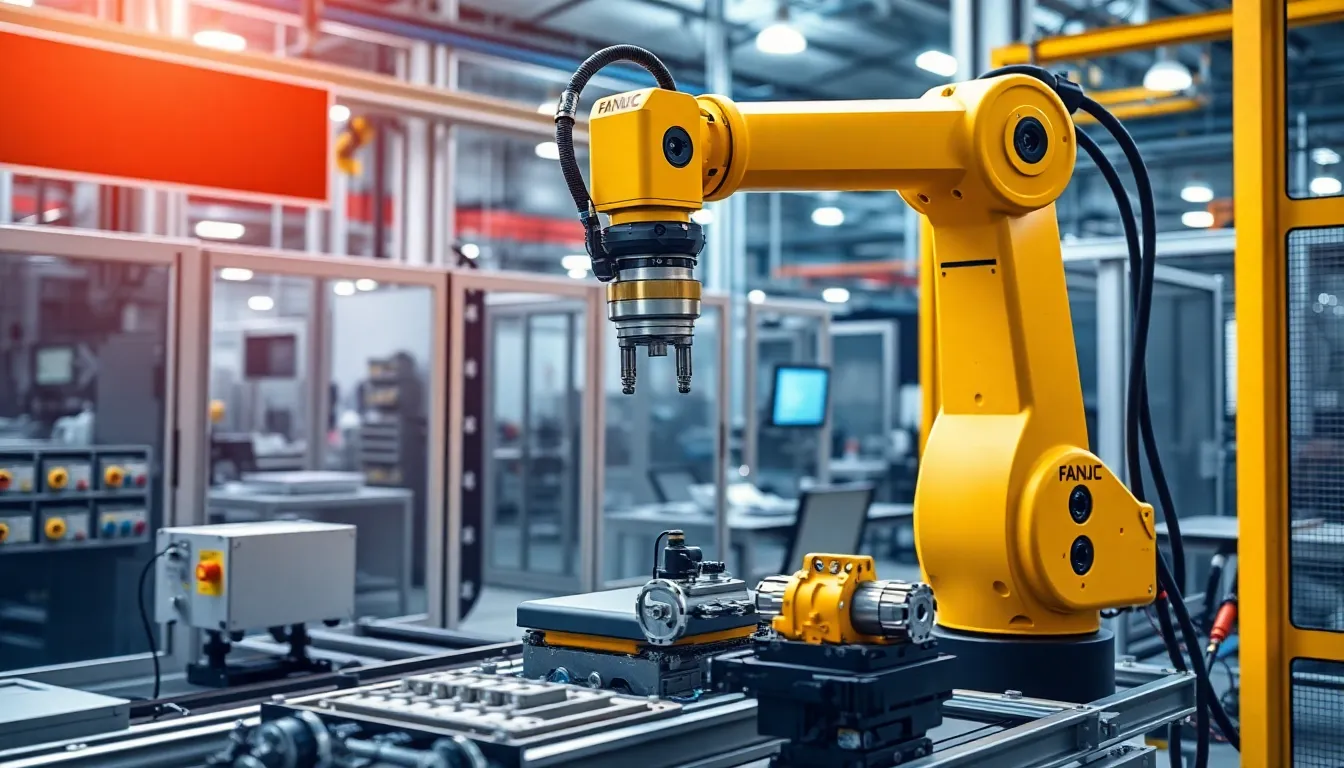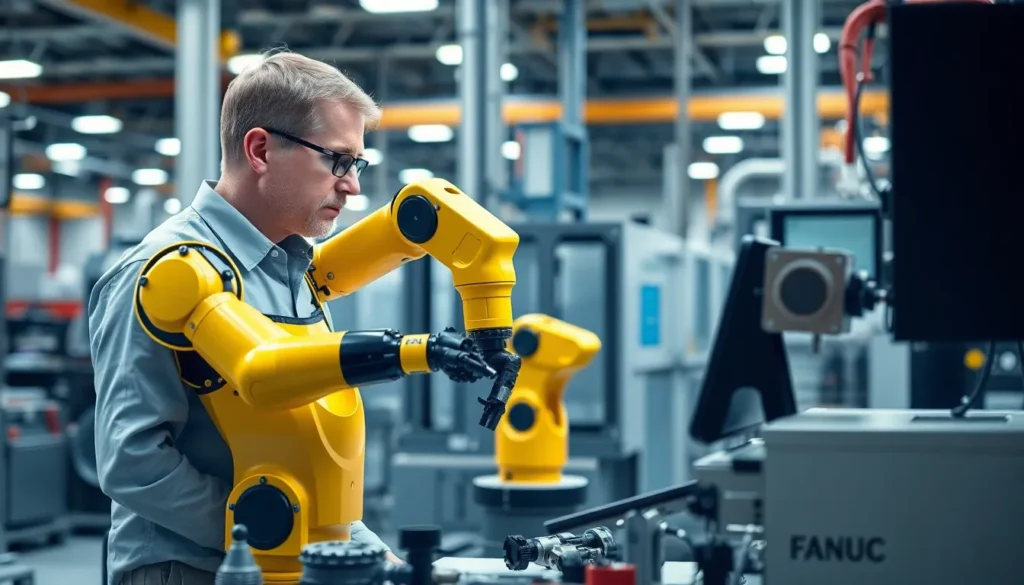In a world where robots are no longer just the stuff of sci-fi movies, Fanuc robot programming stands out as a game-changer for industries everywhere. These sleek, efficient machines don’t just assemble products; they can dance, paint, and even tell a joke or two—if you know how to program them right.
Fanuc Robot Programming
Fanuc robot programming utilizes a user-friendly interface that simplifies the coding process. This programming environment allows operators to efficiently control various robotic applications. Familiarity with the programming language, especially KAREL and ROBOGUIDE, enhances operational capabilities.
Commands in Fanuc programming include movement, I/O control, and task management, enabling robots to execute complex scenarios. Users can build programs using structured data types, which leads to organized and maintainable code.
Safety functions are integral since they protect human operators in collaborative environments. With features like collision detection and emergency stops, Fanuc robots maintain high safety standards during operation.
Additionally, offline programming tools like ROBOGUIDE facilitate simulation of robot tasks without interrupting production. This approach allows for testing and optimizing programs before actual deployment.
Consistency in tasks is achievable with Fanuc robot programming. These robots can repeat their programmed functions with precision, ensuring high-quality output across multiple production cycles.
Regular updates to software further enhance capabilities, providing users with access to the latest features and functionalities. This adaptability supports evolving industry demands and allows for seamless integration with new technologies.
Training resources, such as manuals and online courses, equip users with necessary skills for effective programming. Mastery of programming techniques maximizes robot efficiency, contributing to overall productivity in industrial settings.
Key Features of Fanuc Robots

Fanuc robots stand out due to their impressive range of features tailored to enhance productivity in industrial settings. Their inherent flexibility allows them to perform a myriad of tasks efficiently, while advanced motion control contributes to their precision.
Flexibility and Versatility
Flexible design defines Fanuc robots. They adapt easily to various tasks, including assembly, welding, and packaging. Robots accommodate different payloads, which enhances their versatility. Their ability to work in dynamic environments streamlines production processes. Multiple configurations exist, enabling users to customize setups according to specific needs. Programming options further enhance flexibility, allowing quick adjustments for new tasks or products. Automation solutions benefit immensely from this versatility, leading to increased efficiency across diverse operations.
Advanced Motion Control
Precision defines the advanced motion control capabilities of Fanuc robots. They utilize sophisticated algorithms to ensure smooth and accurate movements. Robots execute complex trajectories with minimal interruption to production flow. Each motion inherits fine-tuning options to improve task accuracy. Various motion modes, such as linear and circular interpolation, provide users with versatile programming opportunities. Additionally, this advanced control contributes to safe operation, reducing the chances of errors or accidents. The culmination of these features results in high-quality output across multiple manufacturing applications.
Programming Languages Used
Fanuc robots utilize several programming languages for effective operation. Understanding these languages enhances the programming experience and optimizes robot performance.
Teach Pendant Programming
Teach Pendant programming serves as an intuitive method for programming Fanuc robots. Users can directly interact with the robot through a handheld device. Visual interfaces simplify task instruction, enabling quick adjustments to robot movements. Operators teach the robot pathways and tasks by manually guiding its arm, which promotes efficient learning. This approach allows for immediate testing of programmed sequences, providing instant feedback and enhancing user confidence.
PC-Based Programming
PC-Based programming offers a more advanced approach for complex tasks. Utilizing software like KAREL, programmers can create sophisticated algorithms that guide robot behavior. Enhanced coding flexibility supports integration with other systems, enabling seamless communication across devices. This method also includes offline programming capabilities through applications like ROBOGUIDE, allowing for simulations and testing without disrupting production. Efficient debugging processes within the PC environment contribute to streamlined development and optimization before actual deployment.
Applications of Fanuc Robots
Fanuc robots find applications across multiple industries due to their versatility and precision. Their widespread use in manufacturing enhances productivity and efficiency.
Manufacturing
In the manufacturing sector, Fanuc robots automate repetitive tasks and reduce human error. These robots excel at machining, material handling, and quality control, contributing to streamlined operations. By utilizing advanced sensors and vision systems, they ensure precise assembly and inspection processes. Significant time savings result from their ability to operate continuously with minimal downtime. Overall, implementing Fanuc robots in manufacturing leads to improved output and reliability.
Assembly and Packaging
Fanuc robots play a crucial role in assembly and packaging operations. They handle diverse tasks, from picking components to placing them accurately on assembly lines. Adjustments to various payloads allow these robots to work with different product sizes seamlessly. In packaging, they package products efficiently, ensuring consistent quality and speed. Implementing Fanuc robots reduces labor costs while increasing throughput in high-demand environments. Their adaptability positions them as vital components in modern assembly and packaging operations.
Challenges in Fanuc Robot Programming
Fanuc robot programming presents several challenges that can hinder efficiency and performance. Understanding these hurdles is essential for successful implementation.
Common Issues
Inconsistent programming can lead to unexpected robot behavior. The complexity of KAREL and ROBOGUIDE may overwhelm new users, making the learning curve steep. Limited access to troubleshooting resources often adds to user frustration. Integration issues can arise when linking robots with existing systems, causing delays in development. Communication breakdown between the robot and human operators often results in increased downtime. Variability in work environments can complicate programming due to changing payloads and task requirements.
Solutions and Best Practices
Establishing comprehensive training programs can improve user proficiency with Fanuc programming languages. Leveraging simulation tools like ROBOGUIDE allows for pre-deployment testing, reducing integration problems. Regularly updating software ensures the robots adapt to changing industry demands effectively. Setting up clear documentation and communication channels helps minimize misunderstandings between operators. Engaging in community forums offers additional support, providing solutions to common programming challenges. Finally, developing adaptable programming techniques enhances robots’ flexibility, allowing for smoother transitions in varied operational settings.
Conclusion
Fanuc robot programming stands as a pivotal element in modern manufacturing and automation. Its user-friendly interface and advanced programming capabilities empower industries to harness the full potential of robotic technology. By embracing tools like Teach Pendant and ROBOGUIDE, users can streamline processes and enhance productivity.
The versatility of Fanuc robots allows them to adapt to various tasks, ensuring high-quality output and efficiency. As industries continue to evolve, the importance of robust programming and ongoing training cannot be overstated. Overcoming programming challenges through effective strategies will further elevate the role of Fanuc robots in driving innovation and improving operational performance across diverse sectors.



